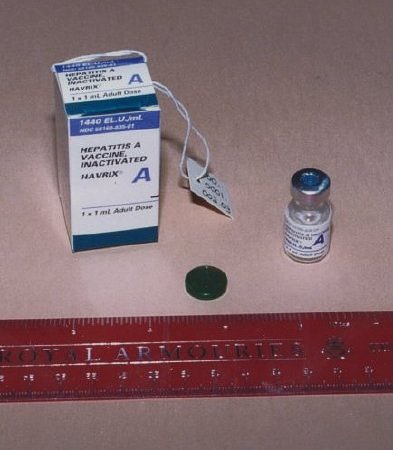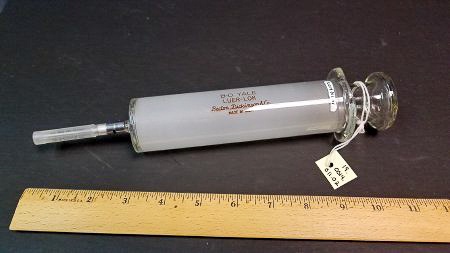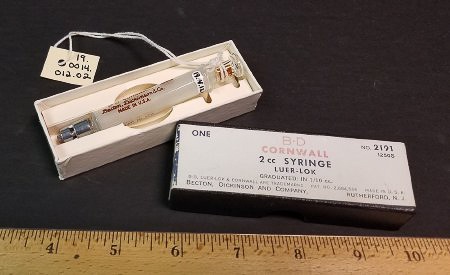Miscellaneous Photos
Soapstone Sink
Dr. Finlayson’s DEAE Cellulose Column
Dr. John Finlayson’s Diethylaminoethyl cellulose column inside the cold room in Building 8 before being moved to Building 29, 1st floor. Diethylaminoethyl cellulose is a positively charged resin that was used in ion-exchange chromatography. FInlayson Photo Collection at the Office of NIH History & Stetten Museum
Diphtheria and Tetanus Toxoids and Acellular Pertussis Vaccine
North American Vaccine, Inc. Diphtheria and Tetanus Toxoids and Acellular Pertussis Vaccine from 1990s. Research by Dr. Pittman and staff at DBS led to advances in the pertussis vaccine. Office of NIH History & Stetten Museum
Hepatitis A Vaccine
SmithKline Beecham Biologicals Hepatitis A Vaccine, Harvix, adolescent dose. NIAID’s Drs. Robert H. Purcell, Suzanne U. Emerson, and Jeffrey I. Cohen, and the FDA’s Drs. Stephen Feinstone and Richard Daemer of the Center for Biologics Evaluation and Research, developed and patented a hepatitis A virus (HAV) and related technology used to develop the vaccine. Office of NIH History & Stetten Museum
Syringes
Becton, Dickinson & Co. Yale Luer-Lok 100 cc Syringe from between 1953 and 1970. In 1934, BD introduced the BD Yale Luer-Lok™ Syringe, designed and patented by Fairleigh S. Dickinson, Sr. It provided a simple, secure method of attaching and removing a needle to and from a syringe. Today, Luer-Lok connectors are the standard for syringes in the United States. Office of NIH History & Stetten Museum
Becton, Dickinson & Co. Cornwall 2 cc Syringe dating from 1954 to 1970. The patent was filed June 12, 1948, and granted to Henry G. Molinari on July 27, 1954. The patent was assigned to Becton, Dickinson & Co. From the patent claims: "...the assembly should include not alone a glass barrel or cylinder, but also a piston or plunger rod of glass slidable within that barrel. By movement of the latter not alone may medicament be expelled from the barrel for purposes of injection, but also that medicament may be drawn into the cylinder to charge the syringe with a suitable quantity of desired liquid....the barrel is usable with only the particular plunger selected for same....it is a primary object of the invention...[that] these assemblies will have their parts interchangeable so that it will be unnecessary to, for example, identify the barrel and plunger by identical serial numbers." Note that such serial numbers ARE on this syringe. Office of NIH History & Stetten Museum
Overview
Content Tools
ThemeBuilder






